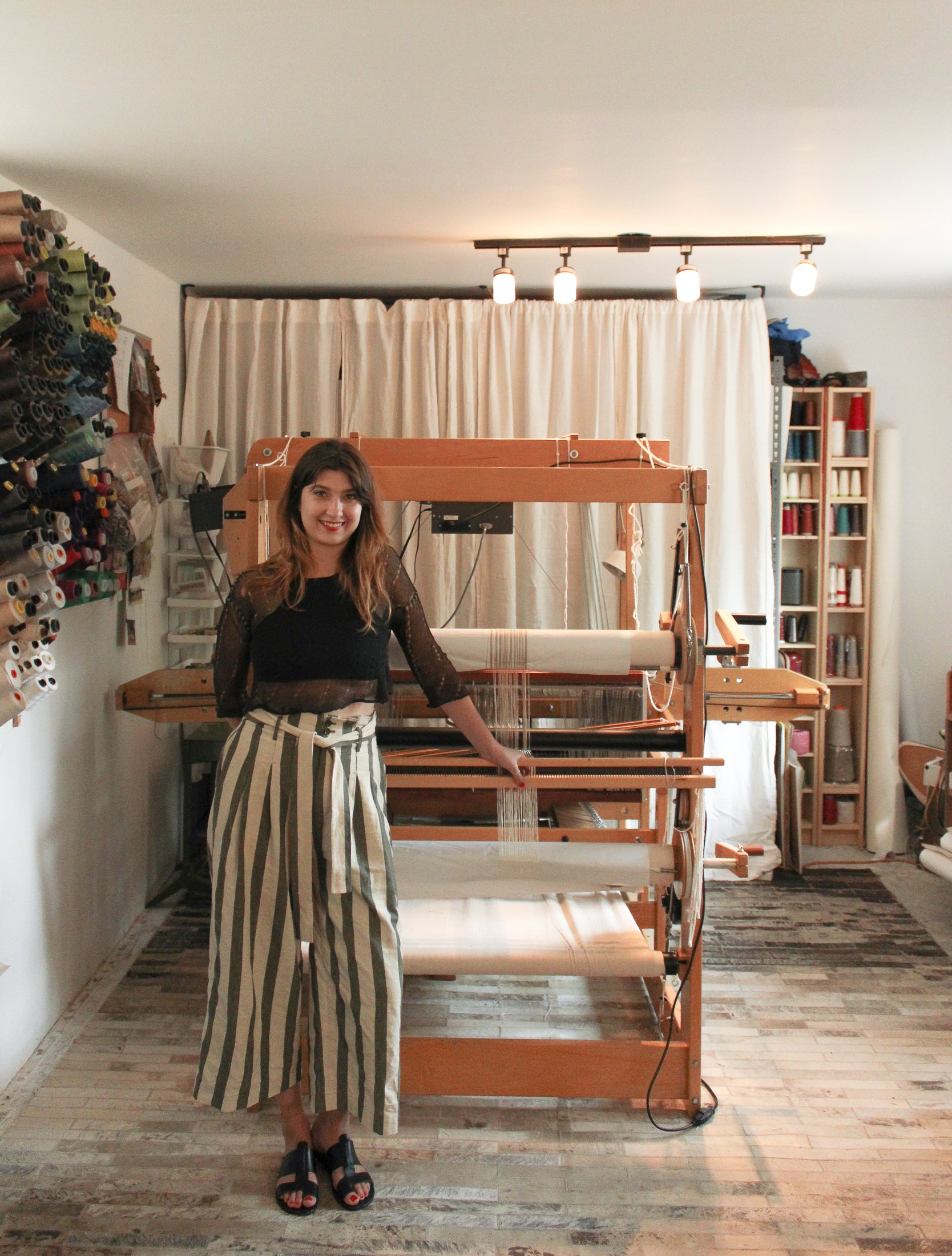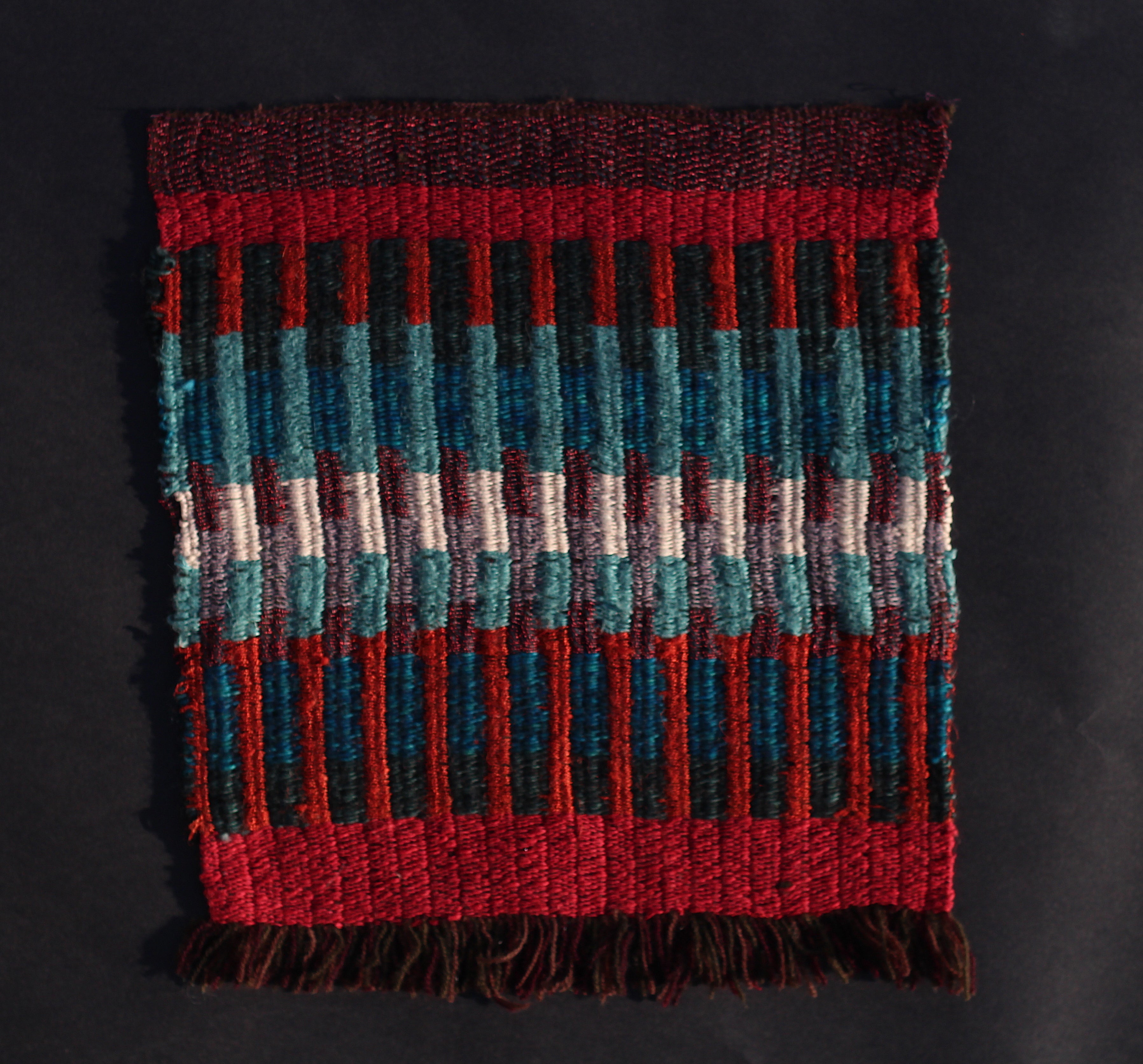
From behind a sizeable 8-foot-wide-by-6-foot-high loom inside her Silver Lake studio, Iris Murphy commands bobbins of paper and silk, jute and upcycled yarns across 24 harnesses, interworking the textures into singular works of textile artistry that run the gamut from interiors to performance, fashion to fine art.
This native Angeleno is ever mindful of waste, especially given the beauty of the fibers and other materials in her work, upcycling and recycling whenever possible. No one is the wiser given the outturn of the tassels she fashions from otherwise discarded yarns. Or the way she incorporates leather remnants. All of which can be seen in her smaller hangings, which include her handmade ceramic rings.

Or there is the massive wall hanging also debuting at A+R during the LA Design Festival. Iris weaved two types of paper yarn, silk-wrapped cotton and metallic synthetic yarns, among others. The mineral squares are mica, a silicate material found as minute scales in granite or as crystals. She peeled each layer of mica and embedded it within pockets of weave work. The results are nothing short of stunning.
Iris began experimenting with fiber arts long before leaving LA for London, where she graduated in 2017 with a degree in Textile Design from the prestigious Central Saint Martins University of the Arts. She returned to the Silver Lake compound where she grew up to focus on weaving, dropping into the studio of her father, accomplished ceramicist Michael Murphy, to use his kiln to make beads for her textile work. Her mother is Beverly Klein, a notable designer, initially known for her fashion label, and more recently, interiors. She recently wed Patrick Baigrie, a post-production sound engineer and deejay/producer, whom she met in London. The creativity spilling over here is even remarkable for Silver Lake.
Iris took a few minutes between commissions for interior designers to chat with The Edit about her work and working in the hometown that continues to influence her work:

A+R: Why Los Angeles?
Iris Murphy:As an LA native, I feel very lucky to know it as my home territory, because it is a true hub of creativity and it can foster so many eccentric and diverse microcosms. I have always experienced LA as an incubator which fosters flexibility and a safe place to work outside of “design norms.” The creative community here is a natural fit for my practice.
A+R: You are very much a part of the “slow” movement in your artisanal approach to tapestry and textile making. Why did you decide to go this route?
IM: Weaving chose me. Before I discovered it, I had never felt such a deep connection to a practice, or anything... I am attracted to the infinite range of choices I have to work with, when I’m creating something from the ground up. And because I am working from such a ground-up position (literally starting with a fiber!) weaving offers opportunities to solve problems, which in turn allows for a lot of diversity in my work.

A+R: What are the challenges in making modern day admirers understand the complexity, resources and time involved in your textile making?
IM: That fabric can occupy so many spaces, physically, emotionally and practically.
It can be high art or serve an everyday use, and all of these markets provide opportunity for, as well as count on, innovation and beauty. I often feel that fabric as a medium is overlooked, which can be both a weakness and a hidden power.
A+R: Tell us about your loom, and how you reconcile the old with the now in your production and in your aesthetic view.
IM: It is an AVL 40-inch, 24-harness Compu Dobby, made in 1991. When it was built, it was manual. It was later reconditioned to be semi computerized, which makes working on it wonderful, as I have a lot more freedom to change things up as I go.
I find that being connected to the tactility of traditional practice is my biggest strength in how I navigate designing. I really enjoy leaning into “old tech,” as it is the properties of a material or a group of fibers that inform me, rather than something digital. This tactile relationship and manual method push me further within the boundaries of what I think it can do, as it forces me to have a one-on-one dialogue with my tools and tangible palette, as opposed to working with a virtual resource.
A+R: Where do you go in LA for creative inspiration and why?
IM: The best inspiration for my work comes from contrasting elements. My favorite example is the LA River with the nature bursting through industrial infrastructure.
A+R: When creative friends from out of town visit LA, where do you take them and why?
IM: I love when friends visit. It forces me to slow down and really see LA in new ways. It allows for me to make new discoveries for myself in so many neighborhoods that I’d probably not make it to otherwise, and to share personal and unforgettable moments with my friends and family. My favorite neighborhoods to share are Chinatown, Little Tokyo, Frogtown and Angeleno Heights.
One of my favorite aspects of L.A. culture is the wonderful and diverse assortment of residential architecture styles. I love showing Los Feliz for its Storybook architecture. It’s a trip to reveal that this style originates from the birth and early days of Walt Disney Studios and its significant home base in this pocket of Los Angeles.
My favorite museums to go to are the Craft Contemporary and the La Brea Tar Pits, which are conveniently across the street from each other! I also love to show off the Getty. There is nothing else quite like its contemporary grandeur and its spatial relationship to the city.
A+R welcomes this talented rising star for the 2020 Los Angeles Design Festival.


